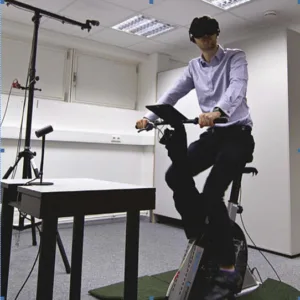A team of researchers headed by Justin Mittelstaedt, a member of the Department of Aviation and Space Psychology at the German Aerospace Center (Hamburg, Germany), has recently reported the results of a study on the effects on cybersickness of display type and means of motion control.

In their article, the researchers start by providing background information on the current state of understanding of cybersickness. They note that, although cybersickness shares many characteristics with motion and simulator sickness, evidence indicates that these conditions are not the same. The reason is that the symptom profiles of the conditions differ and there are also significant differences in overall severity of the conditions.
The researchers go on to explain the incentives for their current study. One reason was to understand the reasons why reports on the occurrence and symptoms of cybersickness have varied considerably in previously published studies. On this point, the researchers speculate that the variation might be due to differences in the composition of the sample of people participating in the tests and/or the setup of the virtual environment. More specifically, the researchers investigated an aspect of this issue by attempting to replicate previous results on the effect of display type and on the means of a virtual avatar’s navigation control on the degree of cybersickness.
A recent article by the team is entitled “Effects of display type and motion control on cybersickness in a virtual bike Simulator.” It was published in Displays 51 (2018) 43-50. A copy of the article can be found here. The publication contains a great deal of information on the composition of the sample of people used in the study, the testing conditions and a detailed analysis of the results. Some of the top level features of the study are as follows.
In the study, participants were instructed to ride a virtual bike across a virtual island. Participants used either a Head Mounted Display (HMD) or a large TV screen for VR presentation. The displays were controlled by one of two means that varied in their “closeness to reality.” These means were a bike ergometer and a gamepad.
One version of the experimental setup: the bike ergometer and the HMD.
In their article, the researchers explain that previous efforts to detect cybersickness used “objective” methods and that these resulted in inconsistent results. As an example, heart rate predicted cybersickness in one study but was found to be unrelated in another. Due to the lack of success with such “physiological methods,” most studies concerning cybersickness now use self-reported questionnaires or symptom checklists to identify the severity of VR-related cybersickness. A customized version of a questionnaire-symptom checklist was used in the current study.
In the study, the occurrence and severity of cybersickness was investigated using three routes through the virtual island each providing a slightly different VR experience. Each experiment included 20 participants. The participants were assessed with a questionnaire just before immersion in VR, on multiple occasions during exposure to VR and after VR immersion.
One particular aspect of cybersickness was a focus of the current study. The researchers looked for answers to the question of why, under any set of experimental conditions, are there substantial differences in the susceptibility of people to VR related cybersickness? Before their study, the two most often discussed variables in relationship to cybersickness were gender and age.
The principle conclusions of the study include the following:
- A HMD induces more cybersickness than a large screen display.
- No difference in cybersickness was found between the bike ergometer and the gamepad motion control.
- Cybersickness with the bike ergometer was correlated to past motion sickness history.
- Cybersickness with gamepad controls was related to the frequency of video game usage.
These last two conclusions seem surprising and would appear to shed new light on the nature of cybersickness.
The researchers conclude their report by suggesting that
“future studies should investigate effects of different virtual vehicles on expectations regarding motion control and in turn on cybersickness. More research is needed on why display types induced different levels of cybersickness within VR and why these differences disappeared in the post-immersion assessment. The influence of demand characteristics in multiple assessments of cybersickness has to be determined.”
Arthur Berman

